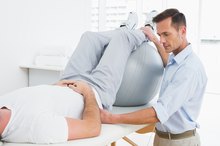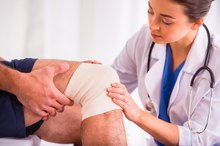4 Treatments for a Torn Shoulder Ligament
Shoulder ligaments are fibrous bands that hold the bones of the region together and stabilize the shoulder joints. Sports injuries, trauma and repetitive stress can cause tears in one or more of the shoulder ligaments 1. These tears range from mild to severe.
If you are experiencing serious medical symptoms, seek emergency treatment immediately.
Tips
Frequently used treatments for a torn shoulder ligament include home care (rest, ice and compression), physical therapy and anti-inflammatory medications. Injection therapy or surgery may be used in advanced cases.
Shoulder Injury Diagnosis
Physical examination, medical history and imaging tests are the diagnostic tools that aid health care providers in assessing the extent of tearing, which guides the treatment plan 2. Depending on the severity of the injury, a torn shoulder ligament may be treated with rest and anti-inflammatory medicine, physical therapy, injections or surgery.
Rest and Anti-inflammatory Medicines
Will a Torn Rotator Cuff Heal Without Surgery?
Learn More
A torn ligament is called a sprain. Shoulder sprains range from microscopic tearing of ligament fibers to complete tears. Mild shoulder sprains often heal with simple treatment. Resting the shoulder, applying ice and taking anti-inflammatory medicine may be enough to bring relief 3. Cold and heat therapy, along with anti-inflammatory medicines, such as:
- ibuprofen (Advil
- Motrin) or naproxen (Aleve)
- help reduce pain
- swelling
- A torn ligament is called a sprain.
- Mild shoulder sprains often heal with simple treatment.
Physical Therapy for Shoulder Strain
Physical therapy (PT) is typically a cornerstone of treatment for shoulder injuries, including ligament tears 4. Initial PT often involves activity modification to allow healing of the damaged tissue. As pain decreases, PT generally focuses on overcoming shoulder stiffness and strengthening the area.
A therapist may perform shoulder joint mobilizations, which involve moving the arm into various positions to improve range of motion. Stretches and other shoulder exercises help improve mobility and strength. The duration and timing of PT varies, depending on the severity of the shoulder strain and other treatments.
Read more: How to Strengthen Shoulder Ligaments
- Physical therapy (PT) is typically a cornerstone of treatment.
- As pain decreases, PT generally focuses on overcoming shoulder stiffness and strengthening the area.
Injection Therapy and Prolotherapy
Occupational Therapy & Shoulder Rotator Cuff Exercises
Learn More
A torn shoulder ligament typically causes inflammation and pain in the shoulder region, which can severely limit use of the affected shoulder and arm. Inflammation, pain and swelling increase in parallel with the severity of the shoulder sprain. If rest, oral anti-inflammatory medication and physical therapy fail to produce significant improvement, injection therapy may be recommended.
Corticosteroid injections reduce inflammation and pain, which can help you tolerate and more fully participate in physical therapy. Some health care providers employ prolotherapy for shoulder sprains, particularly if the ligament injury results in ongoing laxity and instability of the joint 5.
In prolotherapy, a natural irritant is injected into the soft tissues in and around the shoulder joint 356. Although the mechanism of action remains unclear, the intent is to induce a controlled level of localized inflammation to promote healing. While some health care providers report success with this form of injection therapy, it is not suitable for some patients with other chronic conditions, such as Crohn's disease.
- A torn shoulder ligament typically causes inflammation and pain in the shoulder region, which can severely limit use of the affected shoulder and arm.
When Surgery Is Needed
Unfortunately, some shoulder ligament tears will not heal properly without surgery. This is particularly true for severe shoulder sprains and complete ligament tears. Surgery to repair a torn shoulder ligament aims to restore stability so the shoulder joints can function normally.
Surgery may be recommended as initial treatment for people with a complete shoulder ligament tear. For those with a severe shoulder sprain but without a complete tear, a trial of nonsurgical therapy may be recommended first to see if the injury will heal without surgery. People who undergo surgery to repair a shoulder ligament tear participate in physical therapy afterward to regain full function of the joint.
- Unfortunately, some shoulder ligament tears will not heal properly without surgery.
Warnings and Precautions
Shoulder injuries and long-term problems occur commonly in people of all ages. Many types of shoulder injuries share common signs and symptoms, so it's important to see your doctor for an accurate diagnosis and appropriate treatment.
This is particularly important if a shoulder ligament tear is suspected because this type of injury is often accompanied by damage to other shoulder structures. Seek urgent medical care if you sustain a traumatic shoulder injury, especially if your shoulder appears deformed or bruised, or you are unable to move your arm normally 3.
Read more: Exercises for Increased Shoulder Flexibility
- Shoulder injuries and long-term problems occur commonly in people of all ages.
- Many types of shoulder injuries share common signs and symptoms, so it's important to see your doctor for an accurate diagnosis and appropriate treatment.
Related Articles
References
- University of Rochester Medical Center: Common Injuries of the Shoulder
- NYU Langone Health: Diagnosing Shoulder Sprains, Strains and Tears
- Healthline: Treating and Managing Shoulder Pain
- Beamont Health: Physical Therapy's Role in Addressing Shoulder Pain
- Journal of Prolotherapy: Shoulder Prolotherapy Injection Technique
- Healthline: How Does Prolotherapy Work?
- Elbinoune I, Amine B, Wabi M, et al. Rheumatoid shoulder assessed by ultrasonography: prevalence of abnormalities and associated factors. Pan Afr Med J. 2016;24:235. doi:10.11604/pamj.2016.24.235.9068
- Johns Hopkins Medicine. Shoulder arthritis.
- Todd DJ. Patient education: Bursitis (Beyond the basics). UpToDate. Updated January 2. 2020.
- Elbinoune I, Amine B, Wabi M, et al. Rheumatoid shoulder assessed by ultrasonography: prevalence of abnormalities and associated factors. Pan Afr Med J. 2016;24:235. doi:10.11604/pamj.2016.24.235.9068
- Arthritis Foundation. Shoulder anatomy.
- Johns Hopkins Medicine. Shoulder arthritis.
- Wang WT, Huang SW, Liou TH, et al. Patients with rheumatoid arthritis were associated with a risk of rotator cuff diseases. J Clin Med. 2019;8(2):129. doi:10.3390/jcm8020129
- Tzeng CY, Chiang HY, Huang CC, et al. The impact of pre-existing shoulder diseases and traumatic injuries of the shoulder on adhesive capsulitis in adult population: A population-based nested case-control study. Medicine (Baltimore). 2019;98(39):e17204. doi:10.1097/MD.0000000000017204
- American Academy of Orthopaedic Surgeons. Frozen shoulder. Updated March 2018.
- Todd DJ. Patient education: Bursitis (Beyond the basics). Updated January 2. 2020.
Writer Bio
Meredith Victor is a doctor of physical therapy and a certified strength and conditioning specialist. She has more than seven years of combined physical therapy experience, including outpatient orthopedics, acute care and inpatient rehabilitation. Her passion is prehabilitation, which helps prevent postoperative complications and accelerates recovery after elective surgery.









